One of the fun parts of pursuing prototype and experimental firearms is that there isn’t much written or known about many of them – it’s like a great treasure hunt. Of course, the downside is that it’s a lot harder to distinguish originals from fakes, and recognize real stories from ones that have been changed in translation or wholly fabrcated. Case in point, the “StG 45 prototype”. This gun has been on and off the market since the later 1970s, most recently on GunBroker a couple years ago for an asking price of a cool $100,000. You may recognize it:
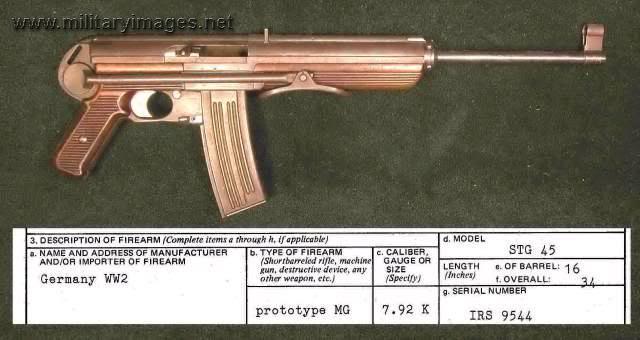
It really is a gun, and a registered transferable machine gun at that – but it’s not an StG45. It’s not German at all. The first clue that something is wrong is the magazine (which I’m sure any one reading this noticed right away). The mag is not an MP44 magazine, it’s too long front to back. Given that the every single other known German late-war prototype stuck with the MP44 mag and the 7.92×33 cartridge, one would have to wonder why this gun would be the lone exception. Next up, the bakelite stock. Pretty much all the late German stuff was stamped.
This thing is definitely not what the seller has claimed it to be. So what is it? Almost certainly Swiss – they experimented with a lot of German-inspired arms ideas (like this one, for instance) in the years following WWII. It’s a legitimately interesting prototype, just not worth anything near the insane asking price (especially given it being chambered in an unknown and thus unavailable cartridge). Well, we just happen to have some photos of it disassembled, in case you are curious:
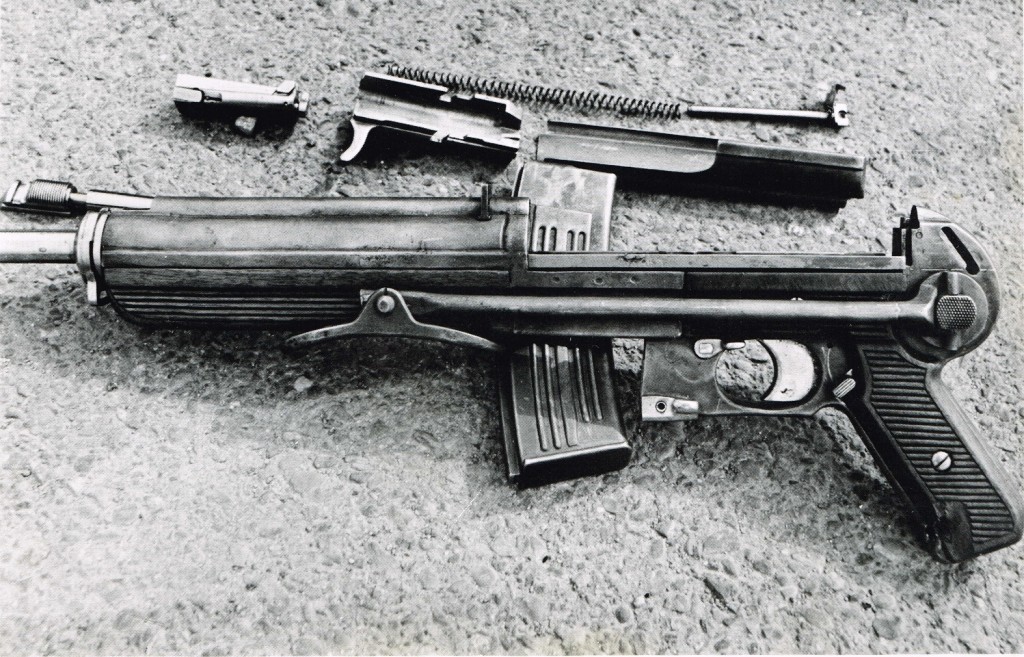
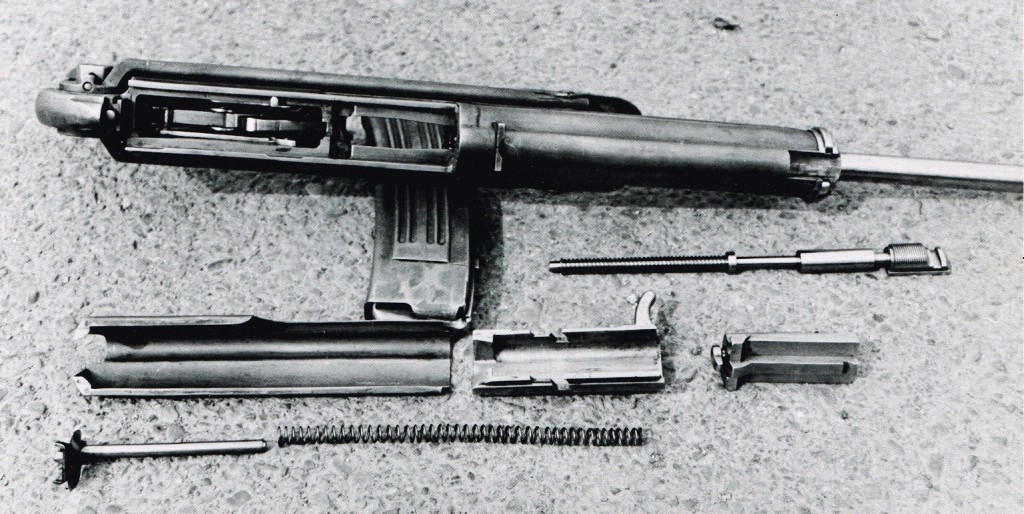
It’s a gas-operated design, with a tilting block bolt. Much more Swiss-looking than German. Caveat Emptor.

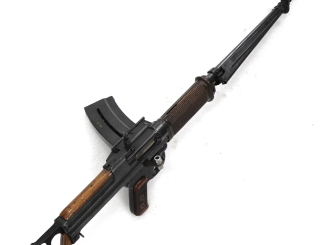

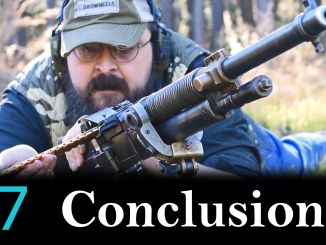
Very interesting. I’ve seen this automatic carbine elsewhere and the magazine always seemed suspect. If not 7.92 Kurtz, anyone hazard a guess as to the chambering?
My guess is the Swiss 7.65×38. Almost as mysterious as the rifle in question.
https://old.municion.org/Swiss/765x38XG.htm
Looks like the love child of an MP40 & a FAL… Wish I could buy one!
Anything possible to build,
ones you got understand how this gun works you can build it…
Caliber could be various 7,62 or 7,92 Kurtz,to build any firearm its recquires great machinist and welding skills…
A real Stg-45 prototype would almost certainly be roller-delayed blowback design, correct? The sights and magazine catch also look very different from any of the other German prototypes of that period. The only thing on it that really looks German is the pistol grip, butstock and rear of the receiver which are obviously heavily inspired by the MP-38/40. I can wonder what caliber this thing is chambered in…
Yep. It would look like this: https://www.forgottenweapons.com/stg45-at-an-ipsc-3-gun-match-video/
I believe there were more than one StG.45 prototypes – we know at least Mauser one (THE Stg.45(M)), Haenel and Grossfuss / Horn
However, neither of these looks like the gun in this post
The caliber could be the experimental 7.62×38 Swiss…
Probably (though I think it would be 7.5, rather then 7.62).
I think both possibilities are likely. The Swiss tested two very similar cartridges in the late Forties/early Fifties, the Mle. 47 (Gewehr Patrone 1947 or simply GP-47), 7,5×38, and shortly afterward the Mle. 53, also known officially as 7,5×38 but with a slightly larger calibre bullet (an actual 7,82mm) – that’s why some ammo buffs and experts (eg Tony Williams) prefer to call the later cartridge 7,62×38 Swiss to distinguish between the two.
The more I think about it, the more I think that a semi-auto only version in .223 using STANAG magazines would be a big hit on the US civilian market. The looks alone would sell big time. Make it cheap enough to shoot (iow use surplus ammo) and it’ll sell at least as well as the Kel Tec SU-16
I’ve actually seen this gun for sale at a Class III gun show in Pennsylvania, though it was a few years ago. I was wondering what it was, since it didn’t seem like an evolution of the STG44.
The answer would be to have a chamber cast made which determine the origin of this rifle. The safety catch on the left side is very similar to Swiss guns of that time,
Why do you think the rifle is gas-operated?
Btw elsewhere on the Internet there are opinions that the rifle in the picture is actually a fake, not a real weapon.
If it is really a Swiss prototype, more info, pictures and so on would be available I supppose. For comparison there are quite many info on other Swiss prototypes of their ‘Sturmgewehre’ (incl. in this formindable website)…
Yeah, I’ve seen people speculate that the gun is fake. It’s not – I spoke to the fellow who took the disassembled photos, and it is definitely a real gun (and a registered NFA weapon) from the mid/late 40s. I say it’s gas operated because that is what he told me, and is knowledgeable enough to know. If anyone can find more info on the gun from some Swiss source, I would love to see it…
The bolt and carrier remind me of an SKS (or perhaps a VZ58, although that has an additional locking block) and the top cover and recoil spring looks like an AK. Is it possible this was made by Russia (or Russian influenced country?) Possibly Czechoslovakia? Although it wouldn’t come under Russian control until 1960.
Now I have a feeling that this may be East German. There were some works upon small arms being undertaken in what was then East Germany.
AFAIK one assault rifle was developed, a derivative of the StG-44 (chambered in 7.62×39). I have an article about it from a Czech magazine published few years ago. Interestingly the article says nothing on the rifle’s proper designation, despite the fact that it was being tested in Czechoslovakia in the late 1950s or ealy 1960s (and the article has been based upon information from the tests).
If the East Germans had built something along the lines of the StG-44, why should they have not built another rifle that took advantage of features of the MP-40, AK, SKS and so on? Naturally if this is the case, the rifle is chambered for the 7.62×39 as well.
Piotr
And here you’ve got the article on the DDR’s assault rifle:
The scanned article:
http://i338.photobucket.com/albums/n430/petrus_optimus/Misc/DDR_StG_4174041_zps5d30b11c.jpg
http://i338.photobucket.com/albums/n430/petrus_optimus/Misc/DDR_StG_4174043_zps4af247be.jpg
I don’t think its swiss as it just doesn’t look right for that either. The mag has little to do with it and you’ll find that there were a number of other developments going on throughout WWII in Germany and other countries as well. Could be Hungarian for that matter. The locking system doesn’t look like any of the swiss systems I’ve seen but the complete gun looks much like the MP40 series and could easily be a development by ERMA or one of their engineers. The thing is gas operated which is not only stated but is obvious by looking at the parts. There is a piston, a port assembly and a carrier which locks and unlocks the bolt by camming it down into a shoulder just behind the magwell. When you look at arms developments throughout the war you see lots of oddball arrangements like the MKb42(w) and the Knorr-Bremse which are not well known but still existed. Offhandly stating that the rifle is swiss without any evidence to back that up is as bad as the guys who claim it is a prototype StG45. If it were Swiss I imagine there would be proofs of some sort. Even prototypes of some pretty obscure types were proofed in Switzerland. On the other hand production guns in Hungary had few proofs of any type….its hard enough sometimes just to find the serial number. Romanian stuff is similar…..why not just claim its romanian?
Timmie
The Swiss also experimented (along with others) with a 7.92x45mm cartridge- I’d bet that’s what this is chambered for.
Surprised to see this show up on the net with misinformation. I bought the gun from a MG dealer – John Fox – in Idaho for $10K in the early 1980s. He said the story was 2 GIs were scouting around some forest hidden & abandon small weapons complex in Germany during the war end of 1945. (Where ????) They discovered the drafting room had 2 of these SMGs. Each guy took one with him. This one has what looks like a shrapnel wound on the lower grip. Maybe it saw some limited combat during development test? I sold it to Bob Starr for $16K in 1986 to finance some big MG barrel purchases in England before the ATF closed the door on imports in May with the 86 law taking effect. Seemed to me, with all the various MGs I had owned back then, it was in fact German.
Do you recall any markings on the gun?
Here are two photos of the rifle in question. One of them may be found at https://smallarmsreview.com/sar-gun-show-east-2010/
[img]https://i.imgur.com/e9w2Jjp.jpg[/img]
[img]https://i.imgur.com/8rPzew7.jpg[/img]
https://i.imgur.com/e9w2Jjp.jpg
https://i.imgur.com/8rPzew7.jpg